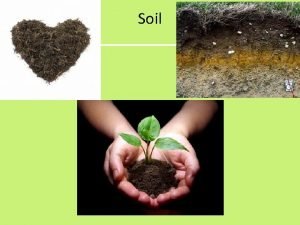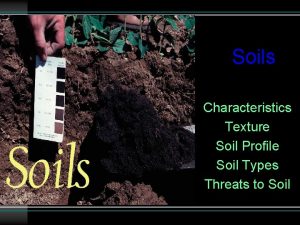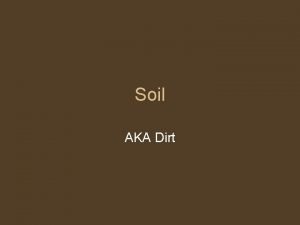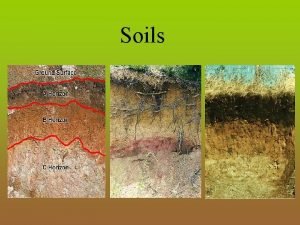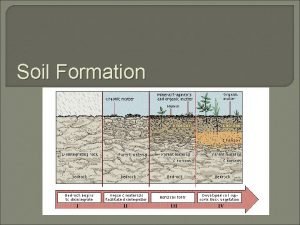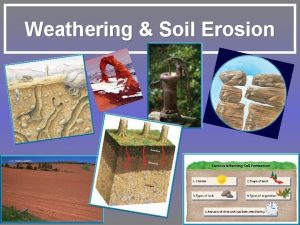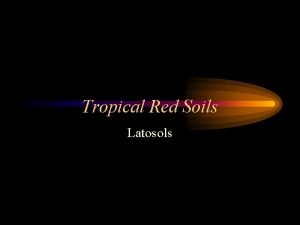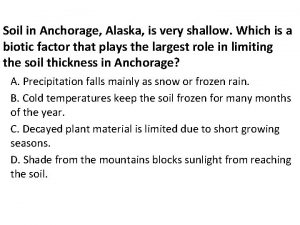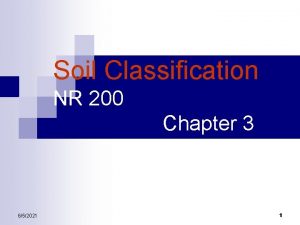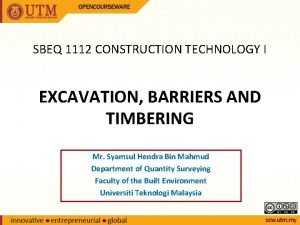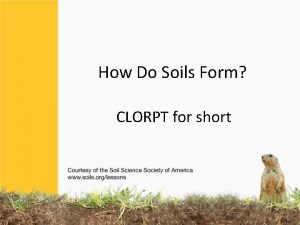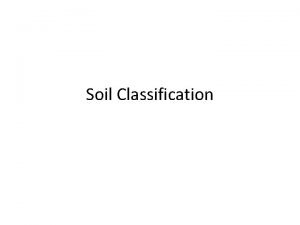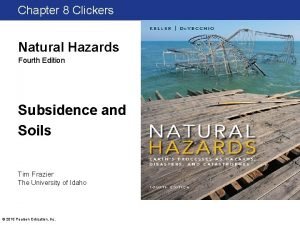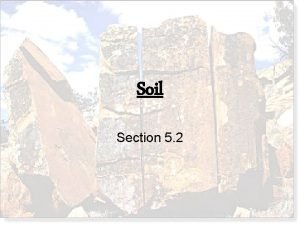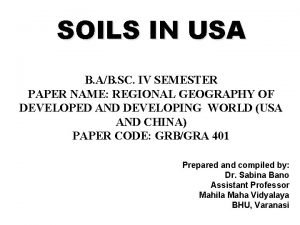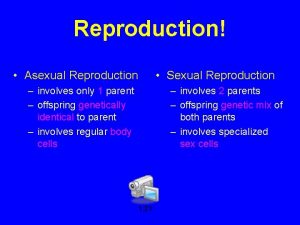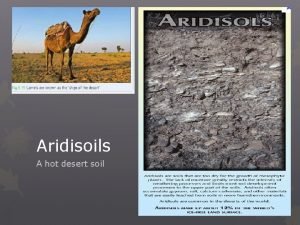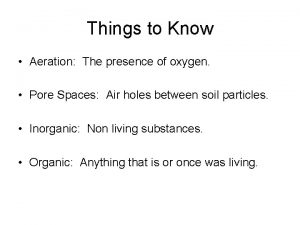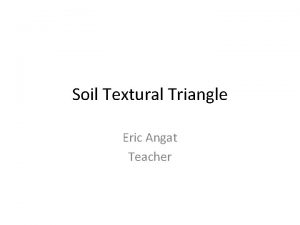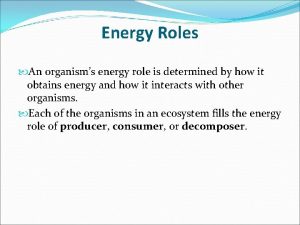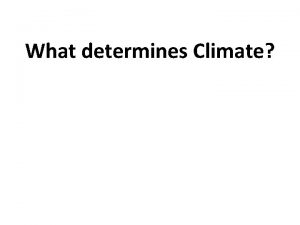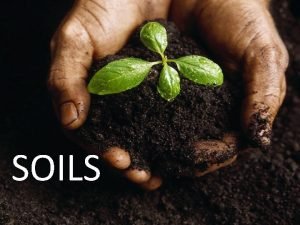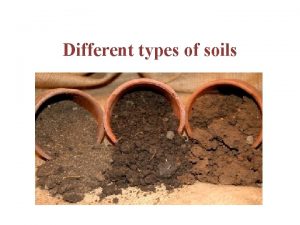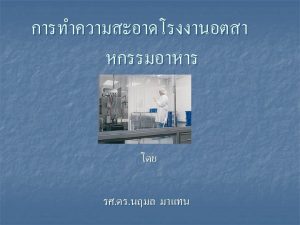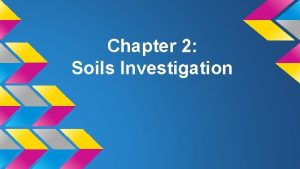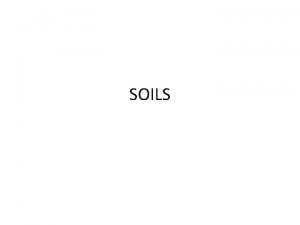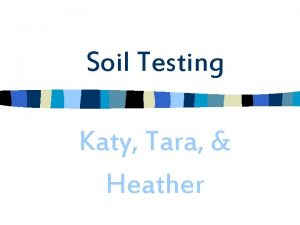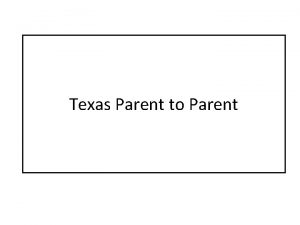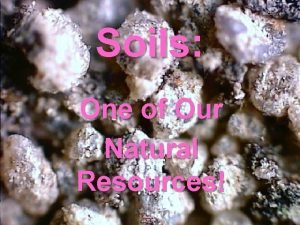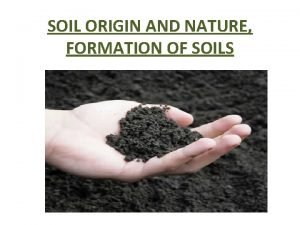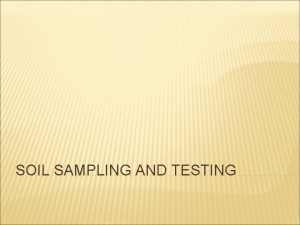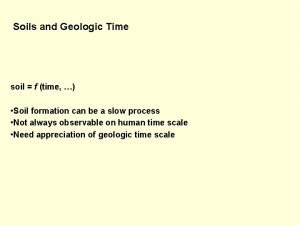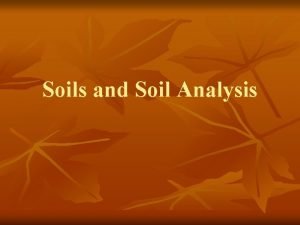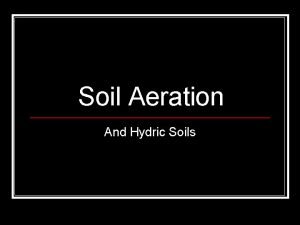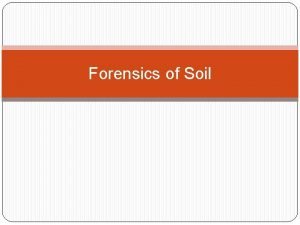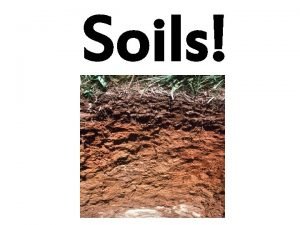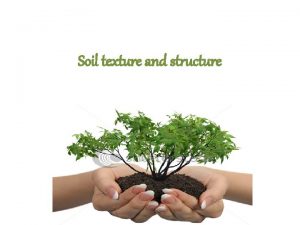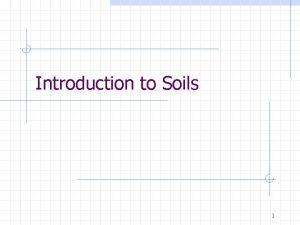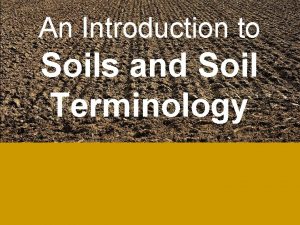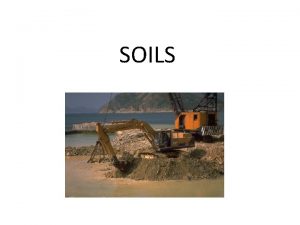Soils What determines the type of soil Parent




























- Slides: 28

Soils

What determines the type of soil? • Parent Material – the type of rocks naturally found in an area – Quartz sand based rocks create nutrient depleted soil that is not good for farming – Soil with calcium carbonate parent material will have plenty of calcium, a high p. H and be good for farming • Climate – need non-freezing temps to encourage decomposition plus climate determines vegetation which provides the organic matter for soil • Topography – geographical features of the area – Steep slopes will constantly erode leading to poor soil – River deltas have seasonal flooding that deposit nutrients and silt which lead to good soil • Organisms – Organisms help churn soil mixing nutrients evenly plus they aid in decomposition and nutrient cycling • Time – It takes a long time for soil to form, so in general older soils are better and more established, but it depends on the vegetation. – Desert soil might be old, the lack of vegetation means it does not improve much with age

Soil formation • Rock is broken down over time by weathering • Organisms live and die, adding nutrients and eventually organic matter • Rate: 1 cm can take 15 -100 years • Over time, distinct layers called horizons form • A renewable resource, but a slow one


Soil profile • Made up of soil horizons – Different textures and compositions • Can be observed by digging a soil pit • Mature soils have 3 or more horizons

O-Horizon • May or may not include the leaf litter layer • Organic detritus (bits of leaves, twigs, etc) on top of a layer of partially decomposed organic matter (called humus) • Soil is brown or black underneath litter

A-Horizon • Topsoil A • Consists of partially decomposed organic matter, inorganic minerals, and living organisms. – dark brown or black usually = nutrient rich = good for farming – gray, yellow or red = low organic matter = poor farming • Zone of biological activity

E horizon – not always present or noted • Zone of leaching • A zone present in acidic soils, – either between the O and A horizon or below the A horizon – always above the B horizon • Nutrients and minerals move quickly through this layer are deposited in the B horizon

B-Horizon n. Yellow alum oxides = n. Red = iron oxides • Sub Soil • Mostly inorganic – rich in Fe, Al, and humic compounds • Nutrients leached down from A horizon • Almost no organic matter n. White = calcium carbonate • Roots may extend into this layer

C-Horizon • Weathered parent material. Broken rock fragments

Soil Profiles by Biome

Soil Matrix • Soil is a mixture of organic and inorganic materials such as air, water, plant and animal materials • 50% = inorganic and organic particles • 50% = open areas called pores

What is in soil? • Organic – Decomposing material • Leaf litter • Dead plants and animals • Provide nutrients! – Living organisms • • Bacteria Soil-invertebrates DECOMPOSERS All require oxygen • Inorganic – Minerals • Macronutrients – primary – N, P, K – Secondary – Ca, Mg, S • Micronutrients – B, Cu, Fe, Cl, Mn, Mo, Zn – Rock • Pores – Store O 2 and nitrogen gas – May fill with water and roots

Soil Texture • Textures – Sand - biggest particles (0. 05 – 2. 00 mm) – Silt – (. 002 -. 05 mm) – Clay – smallest components (less than. 002 mm) • Determined by the % of each type of particle – Gritty = sand – Smooth = silt – Sticky = clay

Soil Texture Importance • Impacts – Too sandy = rapid infiltration and nutrient loss – Too much clay = no infiltration, too hard, roots suffocate, drown, or can’t penetrate – Too silty = compact easily, crusty surface • Loam – a mixture of sand - silt - clay • 40 -40 -20 – BEST for farming! – Promotes drainage while also retaining nutrients

• Porosity – The percentage of open pore space in soil – Silty soil holds water well – Coarse soil holds air • Permeability – The rate at which water flows through soil – Determined by porosity and structure

Soil p. H • The soil p. H is a measurement of the acidity or alkalinity within the soil. • Soil p. H is the negative logarithm of the hydrogen ion concentration. p. H correction Too acidic • Add lime to neutralize • Must be used with organic fertilizer Too Basic • Add sulfur which is converted to sulfuric acid • Very SLOW • The p. H scale goes from zero to fourteen. < 7 = acidic 7 = neutral > 7 = basic • A p. H of 6 -7. 5 is best for most crops

Acidic soils • Acidic soils – Hinder nutrient availability – Increase availability of toxic heavy metals • Major problem for urban gardens in the northeast US – Increase pesticide runoff – Decrease bacteria populations less nitrogen fixation • Soil in California tends to be basic • Soil in the northeastern US is more acidic

Soil Profiles from Time Magazine

A toxic white crust runs through irrigated fields in Grand Valley, Colorado: Moisture evaporating from the soil has drawn underground salt to the surface. To keep the salt from damaging the roots of their crops, farmers must add even more water.

Thick, six-foot-long roots of sunflowers, side-by-side with the roots of assorted prairie grasses, delve deep into a plot of earth near Salina, Kansas. This soil has never been broken by a plow. These perennials have root systems that expand strengthen year after year—unlike annual crops that demand much of the soil but provide little in return. Such growth not only helps prevent erosion but also serves as a water-storage system that enables the plants to survive during droughts.

Virgin Prairie—Kansas, United States. Rancher Jim Duggan holds a stalk of big bluestem, one of the native grasses growing on 40 acres of his farmland that have never been plowed. "This land is the best there is, " he says. "It's class-one river-bottom soil. " Compared with tilled fields, the parcel has deeper, richer topsoil and soaks up more rain.

Reclaimed Fields—Keita District, Niger. Mariama Abdoulaye feeds her family with millet she grows on once barren land. After severe droughts in the 1970 s and ’ 80 s, the UN Food and Agricultural Organization enlisted Abdoulaye and 10, 000 other women to plant millions of trees. Tree roots block wind-driven erosion and help rain penetrate the earth.

Rice Terrace—Yunnan Province, China. Perched on an earthen retaining wall, Zhu Minying holds cords used to bundle harvested rice. Soil here reflects human activities that began with reshaping hillsides into grand staircases of grain. Rice stubble left to decay in the field, manure, and fish raised in the paddy water, all add nutrients to Zhu's soil.

Dry Land—Khanasser Valley, Syria. Farmers like Ismail Hassoun Hariri struggle to grow even hardy barley in this parched land. Soil and rock eroded from surrounding hills lie thick in the valley, but annual rainfall averages only nine inches. In some very dry years the barley crop fails to mature and can only be used to feed sheep and goats.

After losing a foot of soil from parts of their Iowa corn farm, the Reed family changed the way they prepare fields for planting, to limit erosion. Cletus Reed, 80, hopes his grandson, Sam, will work these acres someday. "The land takes care of us as we care for it, " he says.

Tiny earthworks stipple bare slopes in China's Zizhou County, each intended to cradle a single sapling. Government mandated reforestation programs are intended to halt erosion, but many earlier efforts here in the Loess Plateau failed when newly planted trees died.

Organically farmed soils (at left) have a more cohesive structure, which results in less silty runoff than found with conventionally farmed soils (at right). These samples come from the Farming Systems Trial at the Rodale Institute near Kutztown, Pennsylvania. For 28 years, a plot of land there has been managed organically: Researchers rotate crops regularly, grow cover crops in winter, and apply no chemical fertilizers or pesticides. Laboratory analysis shows that organically managed soils produce lots of glomalin, a gluey protein that helps earth hold its ground.
 4 components of soil
4 components of soil What determines baby's blood type
What determines baby's blood type Soil horizon parent material
Soil horizon parent material Soil located above its parent material
Soil located above its parent material Soil horizon parent material
Soil horizon parent material Soil horizon parent material
Soil horizon parent material Living soil vs dead soil
Living soil vs dead soil Four major spheres of the earth
Four major spheres of the earth Weathering and soil erosion
Weathering and soil erosion Tropical red soils
Tropical red soils Soils alive
Soils alive The finest-grained soils are richest in
The finest-grained soils are richest in Prairie soils (mollisols) are _______.
Prairie soils (mollisols) are _______. Use of continuous tubular rail as a barrier to excavations
Use of continuous tubular rail as a barrier to excavations Soil clorpt
Soil clorpt Soil taxonomy definition
Soil taxonomy definition How does the study of soils help evaluate natural hazards?
How does the study of soils help evaluate natural hazards? Soil that forms on unconsolidated deposits is called
Soil that forms on unconsolidated deposits is called A nation that destroys its soils
A nation that destroys its soils Ashley soils
Ashley soils Pedalfer soil
Pedalfer soil Involves only one parent
Involves only one parent Soil layers
Soil layers Soil structure
Soil structure Soil texture triangle activity
Soil texture triangle activity Energy roles
Energy roles Diction is what determines a poet
Diction is what determines a poet Kernel dynamic memory
Kernel dynamic memory The ice cap climate type is found in __________.
The ice cap climate type is found in __________.
